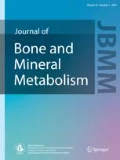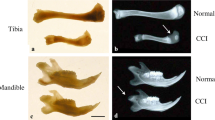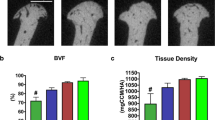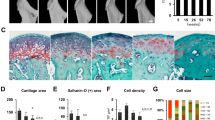Abstract
The effect of aging on type I, II, and X collagen in the mandibular condyle was histologically and immunohistochemically assessed in 1−, 4−, 9−, and 16-month-old rats. Hypertrophic chondrocytes, observed in the 4-month-old rat, were absent in the 9-month-old. In 9- and 16-month-old rats, a mineralizing front ran parallel to the surface of the condyle, and the calcified cartilage was thicker than in the younger rats. Type I collagen was observed from the fibrous layer to the upper maturative cell layer in the 1- and 4-month-old rats. In the 9-month-old, the type I collagen-positive area extended to the whole cartilaginous region. In the 16-month-old, type I collagen took on an archlike configuration around the lacunae. Intense type II collagen reactivity in the maturative and hypertrophic cell layers of the 1-month-old rat was only slightly changed in the 4-month-old. In the 9-month-old rat, immunoreaction was detected from the proliferative cell layer; this extended to the whole cartilage in the 16-month-old. Type X collagen was localized in the hypertrophic cell layer in the 1-month-old and had expanded over the maturative cell layer in the 4-month-old rat. It was detected beneath the proliferative cell layer in the 16-month-old. Type X collagen was always observed in the area immediately above the mineralizing front of the cartilage matrix. Thus, our study indicated that mandibular condylar cartilage becomes fibrocartilage-like tissue with advancing age and that type X collagen may play a pivotal role in the progression of the mineralized front.
Similar content being viewed by others
References
Koike H (1995) Age-related histological changes in rat mandibular condyle. J Bone Miner Metab 13:10–16
Levy BM (1948) Growth of mandibular joint in normal mice. J Am Dent Assoc 36:177–182
Durkin JF, Heeley JD, Irving JT (1973) The cartilage of the mandibular condyle. Oral Sci Rev 2:29–99
Furstman LL (1966) Normal age changes in the rat mandibular joint. J Dent Res 45:291–296
Jee WSS (1988) The skeletal tissues. In: Weiss L (ed) Cell and tissue biology, 6th edn. Urban and Schwarzenberg, Baltimore, pp 211–254
Horton WA (1993) Morphology of connective tissue: cartilage. Connective tissue and its heritable disorders. Wiley-Liss, New York, pp 73–84
Luder HU, Leblond CP, von der Mark K (1988) Cellular stages in cartilage formation as revealed by morphometry, radioautography and type II collagen immunostaining of the mandibular condyle from weanling rats. Am J Anat 182:197–214
Mizoguchi I, Nakamura M, Takahashi I, Kagayama M, Mitani H (1990) An immunohistochemical study of localization of type I and type II collagens in mandibular condylar cartilage compared with tibial growth plate. Histochemistry 93:593–599
Silbermann M, Reddi AH, Hand AR, Leapman RD, Von Der Mark, Ranzen A (1987) Further characterization of the extracellular matrix in the mandibular condyle in neonatal mice. J Anat 151:169–188
Shibata S, Baba O, Ohsako M, Suzuki S, Yamashita Y, Ichijo T (1991) Ultrastructural observation on matrix fibers in the condylar cartilage of the adult rat mandible. Bull Tokyo Med Dent Univ 38:53–61
Mizoguchi I, Nakamura M, Takahashi I, Sasano Y, Kagayama M, Mitani H (1993) Presence of chondroid bone on rat mandibular condylar cartilage. An immunohistochemical study. Anat Embryol 187:9–15
Ishii M (1995) An immunohistochemical study on fetal mouse condylar cartilage (in Japanese). Kokubyo Gakkai Zasshi (J Stomatol Soc Jpn) 62:16–28
Silbermann M, Von Der Mark M (1990) An immunohistochemical study of the distribution of matrical proteins in the mandibular condyle of neonatal mice. I. Collagens. J Anat 170:11–22
Yamada K (1995) Immunohistochemical studies of age-related changes in the mandibular condyle of the senescence accelerated mouse (SAM). J Jpn Soc TMJ 7(3):55–68
Chen WH, Hosokawa M, Tsuboyama T, Ono T, Iizuka T, Takeda T (1989) Age-related changes in the temporomandibular joint of the senescence accelerated mouse. Am J Physiol 135(2):379–385
Vialle-Presles MJ, Hartmann DJ, Franc S, Herbage D (1989) Immunohistochemical study of the biological fate of a subcutaneous bovine collagen implant in rat. Histochemistry 91:177–184
Chung KS, Park HH, Ting K, Takita H, Apte SS, Kuboki Y, Nishimura I (1995) Modulated expression of type X collagen in the Meckel's cartilage with different developmental fates. Dev Biol 170:387–396
Bloom W, Fawcett DW (1975) A textbook of histology, 10th edn. Saunders, Philadelphia, pp 271–273
Moffett BC Jr, Johnson LC, McCabe JM, Askew HC (1964) Articular remodeling in the adult human temporomandibular joint. Am J Anat 115:119–142
Blackwood HJJ (1966) Cellular remodeling in articular tissue. J Dent Res 45:480–489
Flygare L, Klinge B, Rohlin M, Akerman S, Lanke J (1993) Calcified cartilage zone and its dimensional relationship to the articular cartilage in the human temporomandibular joint of elderly individuals. Acta Odontol Scand 51:183–191
Nimni M, Deshmukh K (1973) Differences in collagen metabolism between normal and osteoarthritic human articular cartilage. Science 181:751–752
Nirlich AG, Wiest I, von der Mark K (1993) Immunohistochemical analysis of interstitial collagens in cartilage of different stages of osteoarthrosis. Virchows Arch B Cell Pathol 53:249–255
Sasano Y, Furusawa M, Ohtani H, Mizoguchi I, Takahashi I, Kagayama M (1996) Chondrocytes synthesize type I collagen and accumulate the protein in the matrix during development of rat tibial articular cartilage. Anat Embryol 194:247–252
Joseph AB, Jerry AM, Arthur CV (1987) Skeletal fibrous tissues: tendon, joint capsule, and ligament. In: Albright JA, Brand RA (eds) The Scientific Basis of Orthopaedics. 2nd edn. Appleton & Lange, pp 387–405
Gay S, Müller PK, Lemmen C, Remberger K, Matzen K, Kühn K (1976) Immunohistochemical study on collagen in cartilage-bone metamorphosis and degenerative osteoarthrosis. Klin Wochenschr 54:969–976
Inoue H (1975) The ultrastructure of the articular cartilage and its change (in Japanese). Rinsho Seikeigeka (Clin Orthop Surg) 10(1):25–33
Kubo T (1982) Ultrastructural studies of healing process of injured articular cartilage (in Japanese). Nippon Seikeigeka Gakkai Zasshi (J Jpn Orthop Assoc) 57:167–185
Gibson GJ, Flint MH (1985) Type X collagen synthesis by chick sternal cartilage and its relationship to endochondral development. J Cell Biol 101:277–284
Poole AR, Pidoux I (1989) Immunoelectron microscopic studies of type X collagen in endochondral ossification. J Cell Biol 109:2547–2554
Schmid TM, Linsenmayer TF (1985) Immunohistochemical localization of short chain cartilage collagen (type X) in avian tissues. J Cell Biol 100:598–605
Iyama K, Ninomiya Y, Olsen TF, Trelstad RL, Hayashi M (1991) Spatiotemporal pattern of type X collagen gene expression and collagen deposition in embryonic chick vertebrae undergoing endochondral ossification. Anat Rec 229:462–472
Jacenko O, LuValle PA, Olsen BR (1993) Spondylometaphyseal dysplasia in mice carrying a dominant negative mutation in a matrix protein specific for cartilage-to-bone transition. Nature 365:56–61
Hoyland JA, Thomas JT, Donn R, Marriott A, Ayad S, Boot-Handford RP, Grant ME, Freemont AJ (1991) Distribution of type X collagen mRNA in normal and osteoarthritic human cartilage. Bone Miner 15:151–164
Ekanayake S, Hall BK (1994) Hypertrophy is not a prerequisite for type X collagen expression or mineralization of chondrocytes derived from cultured chick mandibular ectomesenchyme. Int J Dev Biol 38:683–694
Kirsch T, Wuthier RE (1994) Stimulation of calcification of growth plate cartilage matrix vesicles by binding to type II and X collagens. J Biol Chem 269:11462–11469
Kirsch T, Ishikawa Y, Mwale F, Wuthier RE (1994) Roles of the nucleational core complex and collagens (type II and X) in calcification of growth plate cartilage matrix vesicles. J Biol Chem 269:20103–20109
Poole AR, Matsui Y, Hinek A, Lee ER (1989) Cartilage macromolecules and the calcification of cartilage matrix. Anat Rec 224:167–179
Author information
Authors and Affiliations
About this article
Cite this article
Ohashi, N., Ejiri, S., Hanada, K. et al. Changes in type I, II, and X collagen immunoreactivity of the mandibular condylar cartilage in a naturally aging rat model. J Bone Miner Metab 15, 77–83 (1997). https://doi.org/10.1007/BF02490077
Received:
Accepted:
Issue Date:
DOI: https://doi.org/10.1007/BF02490077




